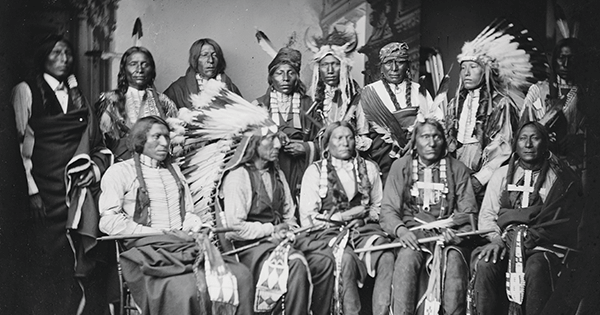
The Earth Is Weeping: The Epic Story of the Indian Wars for the American West by Peter Cozzens; Knopf, 576 pp., $35
In 1970, an unknown (but surprisingly prolific) librarian at the University of Illinois named Dee Brown published Bury My Heart at Wounded Knee, a sweeping and passionate retelling of the 19th-century U.S. conquest of the West from the perspective of Native peoples. Brown’s book has electrified readers ever since, approaching three dozen printings and serving as the basis for a 2007 HBO film of the same name. By his own admission, Brown was not concerned with writing a disinterested account; rather, he sought to cast Indians as the victims of unrelenting settler avarice and aggression. But if Bury My Heart at Wounded Knee endures as a moving indictment of federal Indian policy, it is considerably less successful as an exercise in historical investigation.
In his new book, The Earth Is Weeping, military historian Peter Cozzens aims to “bring historical balance to the story of the Indian Wars,” deliberately adjusting for the heartfelt but nevertheless Manichaean excesses of Brown’s work. This Cozzens surely achieves, in an evenhanded and smoothly written volume that is no less ambitious in scope than Bury My Heart at Wounded Knee. Indeed, the author whisks readers to sites of conflict in all corners of the trans-Mississippi West, from the mountain redoubts of Arizona and New Mexico to the windblown plains of Montana and the Dakotas. All the while, he populates his story with the requisite dramatis personae, many of whom are among the most famous individuals in American history: Custer and Sitting Bull, Sherman and Crazy Horse, Grant and Geronimo, to say nothing of countless others who drove the action.
But for all that, The Earth Is Weeping reads like it is from a bygone era, as if the author had drafted his corrective a scant decade after Brown’s book first appeared. Although Cozzens notes that he has consulted a trove of primary sources made available since the 1970s (a corpus allowing him to render more fully the Native outlook on the events of the time), he seems to have studiously ignored the efflorescence of popular and especially academic history published in the past three decades that has so richly enhanced our understanding of this sanguinary period. In short, The Earth Is Weeping offers a lean and felicitous narrative almost entirely devoid of critical analysis of anything apart from military tactics and strategy.
For instance, readers will learn little new about Indians and their grievances. Instead, Cozzens takes their struggles against the United States largely for granted, beginning in medias res with Red Cloud’s War, inaugurated in 1866 by the Oglalas in response to the blazing of the Bozeman Trail, which facilitated American expansion into the Powder River country of Wyoming and Montana. Cozzens thus dispenses with more than two centuries of Native-white conflict that should contextualize the bloodletting, including the imperial designs of several Indian groups (most notably the Comanches and the Sioux), which helped animate the cycles of violence. Moreover, Cozzens bypasses a pair of seminal events that set in motion the wider contest for the West: the Dakota War of 1862 (which resulted in the largest mass execution in American history, when 38 Indians were hanged on the orders of President Abraham Lincoln) and the infamous Sand Creek Massacre, an 1864 slaughter of Arapahos and Cheyennes by the Colorado militia that ignited Indian rage across the central and southern Plains. Most egregiously, save for a handful of scattered references to the dwindling number of bison, Cozzens elides the environmental crises that brought the Plains tribes in particular to the brink of societal collapse.
If Cozzens does not do much to improve on Brown’s depiction of Indians as noble but static (and doomed) opponents of American westward expansion, he has even fewer fresh insights into the minds of their antagonists, a failure rooted to no small degree in his singular focus on events taking place beyond the 100th meridian. To wit: for all the attention it receives in Cozzens’s narrative, the Civil War may as well have taken place on the other side of the Atlantic Ocean, even though the manpower needs of the Union depleted U.S. forts in the West and thus provided a critical opening for increased Native recalcitrance. Likewise, the Reconstruction-era debates over national citizenship and sovereignty held profound implications for Indians, who—in part because of their armed resistance—were perceived as too warlike and uncultured to enjoy the franchise and full incorporation into the American body politic. These lacunae are all the more surprising given Cozzens’s extensive prior writing about the Civil War and its aftermath.
And yet most disappointing about The Earth Is Weeping are the missed opportunities by the author to ask new questions or to push this well-known narrative in fruitful new directions. For example, some scholars of the Indian experience in 19th-century California (the site of the most dramatic Native depopulation in the West) have argued that the Golden State directed a policy of genocide against its Native inhabitants. Could the same be said of U.S. officials more broadly, and if so, what would be the implications of such a claim? Similarly, what might be gained by adopting a continental perspective, considering also the efforts of Canada and Mexico to conquer their own indigenous peoples, who on occasion sought refuge in the United States (thus turning the tables on the familiar story of American Indians fleeing across the Medicine Line or the Rio Grande to escape the long arm of the U.S. military)? In short, although Peter Cozzens arouses many of the same feelings of sympathy and outrage first stirred by Dee Brown in 1970, The Earth Is Weeping sheds far less new light on this darkest of American eras.


